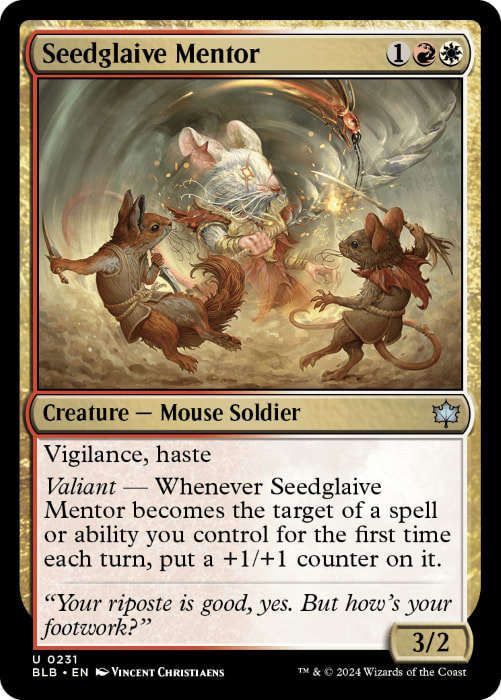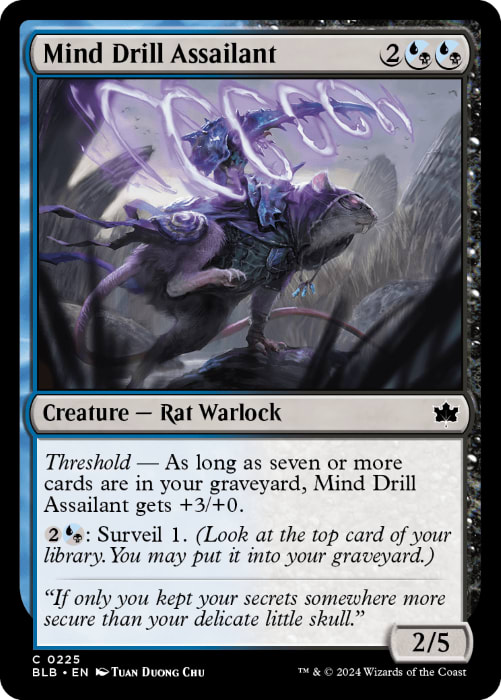I'll be perfectly honest: Bloomburrow is not my favorite draft format. Bloomburrow is probably one of the best flavor-wins for Magic in recent sets. I really like the combination of high fantasy and cute furry creatures, and its art style and worldbuilding remind me of Lorwyn. As Magic moves into more sci-fi spaces, I cherish the traditional fantasy-inspired sets more, and Bloomburrow captures that essence of Magic for me.
The Limited format, however, is not exactly my cup of tea. Bloomburrow is a format that's heavily focused on typal synergies, meaning that during a draft it benefits you greatly to find the open lane at the table (the two-color typal strategy like Bats, Lizards, Otters, etc.) and stay in that lane. This is different from other draft formats in that it feels a bit constricting on what you can and can't do in the format. I think you can draft decks that ultimately just have good cards in them, like removal, creatures with solid stats, but you'll end up losing to decks that have multiple cards that synergize and combo well with each other.
For example, one Long River Lurker on its own is a reasonable Magic card - but when you pair it with a second copy or a Lilysplash Mentor (or both!) you'll have a hard time breaking up a pretty unbeatable combo. There are also just lots of ways in the Simic Frogs deck to blink it! It can be pretty demoralizing to not have any removal against an opponent that can enact a powerful combo multiple turns in a row.
This format has a lot of engines, meaning that you can draft a few mediocre cards that together become a source of card advantage that must be dealt with. Kindlespark Duo and Fireglass Mentor, Seedglaive Mentor and Brave-Kin Duo, Agate-Blade Assassin and Wax-Wane Witness - the list goes on and on. This isn't exactly a knock against the format, as it rewards you for reading the draft signals correctly and making the right picks to find these combo pairs, but I do think it makes it harder for decks to break up these combos. Fell might be your best removal spell, but you'd rather save that for a threat like Quaketusk Boar rather than an engine like Harnesser of Storms.
As a drafter that drifts more to midrange and control strategies, and prioritizing fixing, power, and removal over synergy, this set has definitely been tough for me to navigate. However, I've been finding my way through certain strategies both in drafting and deckbuilding, and I'm here today to shine some light on how you can draft more defensive and controlling strategies in a format that seemingly is all about synergy and finding one lane and sticking to it. Here are the steps I've been taking to accomplish this:
Step One: Drafting the Path Less Traveled
If you've drafted Bloomburrow, whether online or amongst friends at your LGS, you should know by now that Blue is one of the most looked-down upon colors in the format. Even looking at 17lands.com data, we can see what win percentages are like for MTG Arena Best of One games across all 10 color pairs in the format:

As you can see, Golgari and Selesnya are the clear winners, boasting a 57.4 and 57.7 win percentage, respectively. There's a dropoff with the Blue decks by a couple percentage points, the largest delta being 7.1% between Izzet and Selesnya! Izzet, Dimir, and Azorius are the lowest-winning archetypes, with Simic a bit higher due to its pairing with Green, which is arguably the best color in the set based on this data.
Look, if Green is open at the table - by all means, draft your heart out. The issue I foresee happening at 8-player drafts is that at the end of the day, not everyone can be Green. If you think back to formats with a large delta between color combinations, the same issue persists. In Battle for Zendikar you always wanted to be in the Grixis colors since Dimir and Izzet Devoid Eldrazi were the de facto best decks. There were various Orzhov Allies decks, but with Green being the worst color by far, you wanted to stay as far away as possible. But with 8 players and such a small selection of cards is it always worth it to be in the "best" archetype, if you're contesting those colors with at least two other players?
I did a team draft of this format recently in which I started off Selesnya with my first three picks being two copies of Burrowguard Mentor and a Driftgloom Coyote. I wanted to leverage the power level of my first few picks and went hard into Selesnya, picking up an extra Burrowguard Mentor, a Phineas, Ace Archer, and a couple Intrepid Rabbits along the way. However, I became more and more nervous during the draft as I noticed so many Blue cards making their way around the table, such as late Eddymurk Crabs, Knightfishers, and Mind Drill Assailants. When we turned our cards face up my teammates were Naya and Gruul, with me still in Selesnya. We ended up losing that Team Draft.
The biggest lesson our team took away from that is the fact that we shared too many cards and in turn cut each other off from having better decks. Meanwhile, our opponents had a powerful Rakdos Lizards, Orzhov Bats, and okay-ish Bant deck. While we were able to get three wins against the Bant deck, our decks lacked the reach to beat the Bats and Lizards decks. Ultimately either I or my teammate should have made the sacrifice to move into Blue, with our Gruul player probably supposed to be in Jund or Abzan. We could've cut our opponents off from better cards, and while lots of powerful Blue spells wasted their way around the table, we had to settle for mediocre Naya cards for our decks.
Lesson learned: it's okay to draft the decks that are less powerful or determined "bad" by other players or data websites like 17lands.com. While I think it's important to have context about the set so you can leverage drafting the better decks in the format when they're open, if everyone is pining for the same archetypes it will benefit you to be flexible and understand how to make the most of the open archetype at the table.
Step Two: Shoring Up Defenses
So what do you do in this "worst-case" scenario where you find yourself at a Bloomburrow draft and begin to notice the Green and White cards drying up? Let's take a look at some of the pieces you'll need for your defensive strategies. First, you'll need to draft some big butts, some of my favorites are Nightwhorl Hermit, Mind Drill Assailant, Brambleguard Veteran, and Wax-Wane Witness.
Like I mentioned before, this format can be super-fast and unforgiving, so you'll need to have a decent amount of two-drops and four-toughness creatures to stem the initial bleeding. Look, I would love for all of my games of Magic to start with my opponent's creature-heavy deck to not make a play until turn three, but that's sadly not the world we currently live in.
I also think a good rule of thumb for this format is to have at least six, if not more, two-drops - whether they be creatures like Thought Shucker or removal spells like Savor.
There are other cards that help you mitigate early bleeding to gain advantage in the mid-to-late game. Savor is one of my favorite removal spells in this format, mainly for its cost, use as a combat trick, lifegain, and relevance to forage synergies. Wildfire Howl is a card that I think is a great answer to the White go-wide decks, but the issue is the only real Red deck you'd want it in is probably Izzet Otters, the worst two-color combination. I actually think Wildfire Howl might be better suited for some type of Grixis deck, where you can lean on the better Black cards and have your Red spells primarily be removal.
Mindwhisker is a solid card for any Dimir deck, and while it's not a wrath by any means, sticking around on the battlefield while you beat your opponent to death with 2/4 unblockables makes it a pretty useful piece of the puzzle. One thing to be wary about, however, is to be aggressive with your surveilling. Even if you're throwing spells into the yard, if you don't need them right that turn I'd recommend just growing your graveyard as large as possible to hit threshold. Being conscious of this will help you leverage cards like Eddymurk Crab, Thought Shucker, Mind Drill Assailant, Mindwhisker, and your Nightwhorl Hermits better.
In Green, I really enjoy cards with high toughness and ways you can gain life. Bakersbane Duo is one of my favorite commons for this reason, with Heaped Harvest coming in a close second. Three Tree Rootweaver is also very relevant, especially if you lose the die roll, for both mitigating your opponent's turn two creature play, and powering out your powerful cards.
Step Three: Finding the Path to Victory
Okay, so you've got your removal spells, you've shored up the board, now what? You actually have to *win* the game! I think in Blue decks primarily the best way to do this is by getting in unblockable damage. Nightwhorl Hermit in multiples is a pretty hard clock to deal with. Knightfisher is another favorite win con of mine because in the right deck you can also manage the board while getting in damage. I think one of the weaknesses of relying on these individual threats, however, is that so many cards can delay them.
Cards like Sonar Strike, Agate Assault, and basically anything that makes stun counters or bounces for cheap can be pretty annoying to deal with. Galewind Moose is one of Green's best creatures, but it can easily be defeated by your opponent's mopey four-power creature and a singular Crumb and Get It. I think if you want to win the game with singular powerful or evasive threats, you must play and draft in a way that protects them.
Cards like Overprotect and Scales of Shale can work your way out of situations where your opponent tries to gang-block or get fancy in combat with their own tricks or removal spells. Scales of Shale is a card I also think is very important for Black decks, as the lifegain is very relevant if you don't have access to cards that make food, and can very much turn the clock in your favor if you cast it on your 5/5 Mind Drill Assailant, for example.
Overall, I think while it's hard to draft winning defensive decks, it's ultimately an important draft skill to master. Bloomburrow might be all about aggression and synergy, but if you can pinpoint weaknesses in your opponent's game plan and draft the best cards that aren't being sniped by your pod you can cobble together some pretty powerful decks. I think at the local level, the basic strategy is to draft White and Green cards. I cannot stress how powerful it feels to be the one Blue drafter at the table, while the remaining seven players squabble over who gets the best Naya cards.
A Well-Earned Win
I'll leave you with a pretty impactful Limited story from MXP Los Angeles. My team draft teammate, Vincent Bi ended up taking down the Sunday Limited 5k. Clinching a win in a field of 55 players, there were a few key takeaways from Vincent's decks. Let's look at his Sealed and Draft deck, respectively:
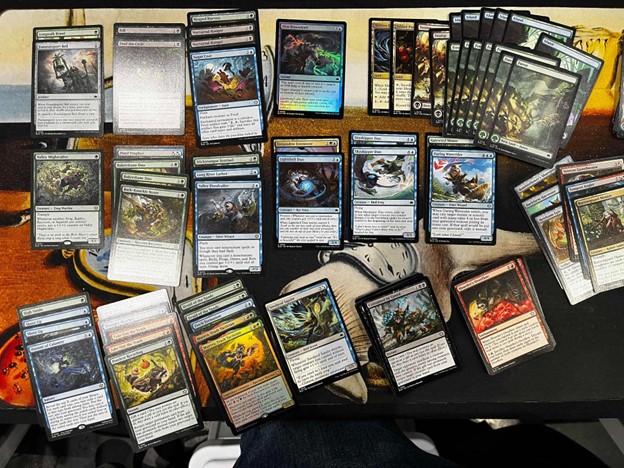
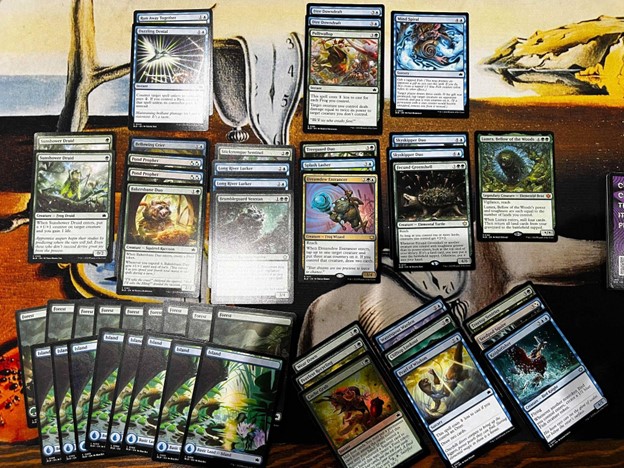
Funny enough, Vincent piloted not one, but two Blue decks to take down the 5k! While both decks did pair Blue with the arguably best color in the set, Green, it shows an important way how you can tackle this format. Vincent's Sealed deck revolves around recurring value, primarily in ways he can rebuy his removal spells. Like I said, a single Fell or Nocturnal Hunger might not get the job done, but when you can flash it back with Daring Waverider, you have some pretty big tempo swings. Speaking of big tempo swings, how about flickering your Dreamdew Entrancer a few times to lock down your opponent's board while your Galewind Moose swings in a few times?
Vincent commented that he built his deck as base Blue-Green, his favorite color combination of the set, but also wanted to leave himself open to splashing since he had different mana-fixing. In more aggressive matchups he opted to swap the Black cards for two copies of Take Out the Trash and Muerra, Trash Tactician.
As for the Draft, Vincent noted that out of the eight decks at the table, he and an Izzet Otters player were the only Blue drafters. There were three Selesnya drafters and three Rakdos drafters. Vincent has some pretty powerful bombs and defensive creatures in his Green cards, including the return of the one and only Dreamdew Entrancer, which was his pack one pick one over Carrot Cake.
In pack one Vincent also noticed that a Dire Downdraft wheeled, a signal that Blue was pretty open as it is one of Blue's premier commons. It even won him a pretty close game in the semifinals to clinch the invite, as Vincent Dire Downdrafted his Stickytongue Sentinel in upkeep to draw it for turn, then blink his Long River Lurker to get in for lethal with an expended Brambleguard Veteran. What a line!
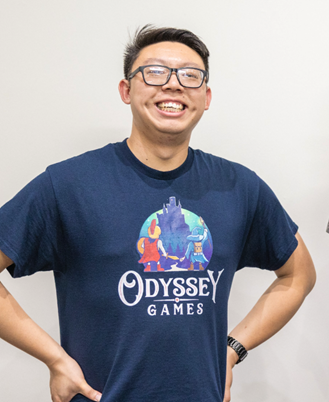
Overall, Vincent commented on the nature of the format having powerful two-card combos, and he mentioned that he highly values Blue-Green as a deck that can act defensively against the White and Red decks while also providing some pretty powerful combos later in the game. He really likes the "value" creatures in Blue and Green, notably Stickytongue Sentinel, Long River Lurker, Bakersbane Duo, and Skyskipper Duo - basically any card that provides an extra piece of value that can be flickered. With the Green cards acting as a solid defense, Blue cards like Daring Waverider, Long River Lurker, and Skyskipper Duo are ways to out-value your aggressive opponents in the mid-to-late game.
Bloomburrow might not be my format, but it definitely feels like it rewards players that stay open and stick to their Draft basics. While it may certainly be correct to be the Selesnya Rabbits or Golgari Squirrels drafter in your seat, keep your options open to the colors less drafted when you sit down for your next FNM or RCQ Top 8. Keeping open and drafting what's considered "unplayable" might actually be what gets you your next regionals invite.

















